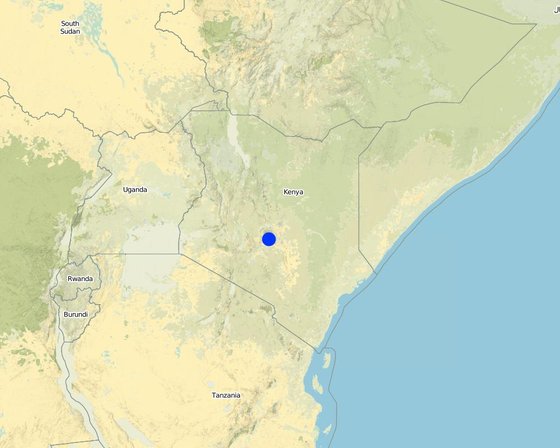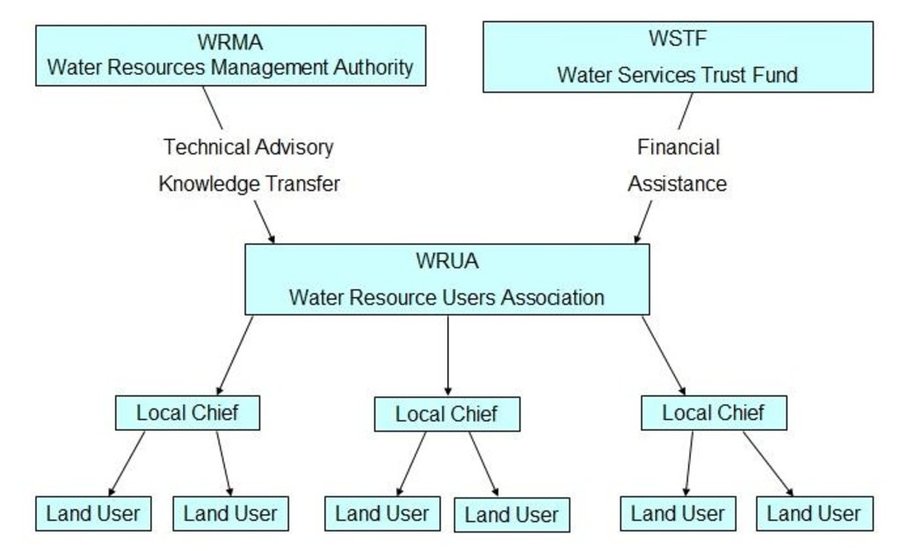

Aims / objectives: The overall objective is to facilitate everybody in the river sub-catchment with sufficient and good quality water supply even during dry spells. Further objectives are to conserve the water catchment, to manage the resources properly, to preserve riverine forests and the riparian ecosystem, stop pollution and establish water use rules that are broadly accepted.
Methods: The WRUA is an association of stakeholders who wants to achieve the objectives mentioned above. During the regular meetings each stakeholder can raise his voice, express his needs and vote in a democratic manner. For outsiders and the government it is also an official contact in terms of water resources.
The WRUA members arrive at a decision together and thus lead to a sustainable development. Together, they accomplish the activities mentioned below.
Stages of implementation: First, a WRUA needs to register at the regional WRMA (Water Resources Management Authority) office, this ensures legal security for the WRUA. The WRMA provides the WRUA with technical and administrative advisory and is part of the Ministry of Water and Irrigation. The members of the WRUA conduct a water abstraction survey in the sub-catchment to identify all legal and illegal water abstractions. It is crucial to know the accurate water flows before you can conserve the water resources. The goal is to convince illegal abstractors to apply for a permit to legalise the abstractions. The WRUA organises meetings, called barazzas, with the local chief and the riparian land users. In these meetings special conservation measures applied in the riparian area are discussed together with land management specialists. The conservation measures are cutting of water guzzling trees, planting of water-friendly indigenous trees, raise public awareness of pollution, rehabilitation of riverbanks and introduction of new technologies like drip irrigation and rooftop water harvesting.
To raise public awareness of the importance of the riparian area, the WRUA members conduct a pegging campaign along the main river of the sub-catchment. The water act 2002 dictates a riparian area of at least 6 metres on either side of the river. This area is being delineated to indicate the location of the protected to the land users.
During water shortages (for example a dry spell), the WRUA publishes rules for water abstractions to ensure water supply for all land users.
Other important information: Furthermore, the WRUA is an important tool for stakeholders for communication and conflict management related to water resources. Due to the immense importance of water for ecosystem services a proper management of this resource is required.

地点: Embu, Eastern Province, 肯尼亚
启动日期: 2000
终止年份: 不适用
方法的类型| 该方法涉及哪些利益相关者/执行机构? | 指定利益相关者 | 说明利益相关者的角色 |
| 当地土地使用者/当地社区 | WRUA members, riparian land users. Patrols stay in contact with land users | The land ownership is traditionally designated to the husband of the family. Therefore 90% of the participants at the barazzas were men. |
| SLM专家/农业顾问 | WRMA | |
| 国家政府(规划者、决策者) | WRMA (Water Resource Management Authority) Chiefs organised barazzas. |
The Chart shows how WRMA and WSTF support the WRUA with knowledge, technical advisory and financial assistance. The WRUA, composed of land users, is in contact with the land users via the chief.

决策是由......做出的
决策是基于
The most recent knowledge in riverbank protection and land conservation was communicated by the WRMA to the WRUA and from the WRUA to the land users. Subjects treated are planting of waterfriendly indigenous trees and chopping of water guzzling eucalyptus trees, as well as riverbank stabilization with trees and Napier grass. Furthermore, pollution prevention and new water-saving land use technologies are discussed.
Meetings
土地使用者的劳动力为
Water quality has been improved, riverine wildlife habitats have been enlarged, water storage capacity of the riparian zone has been ameliorated, vegetation cover and biodiversity have been increased.
Neighbouring communities also installed Water Resource Users Associations to manage the water use. Since 2002 this process was supported by the governmental institution WRMA.
They just have to keep applying the conservation measures. Public awareness raising and patrols by the WRUA have to continue.